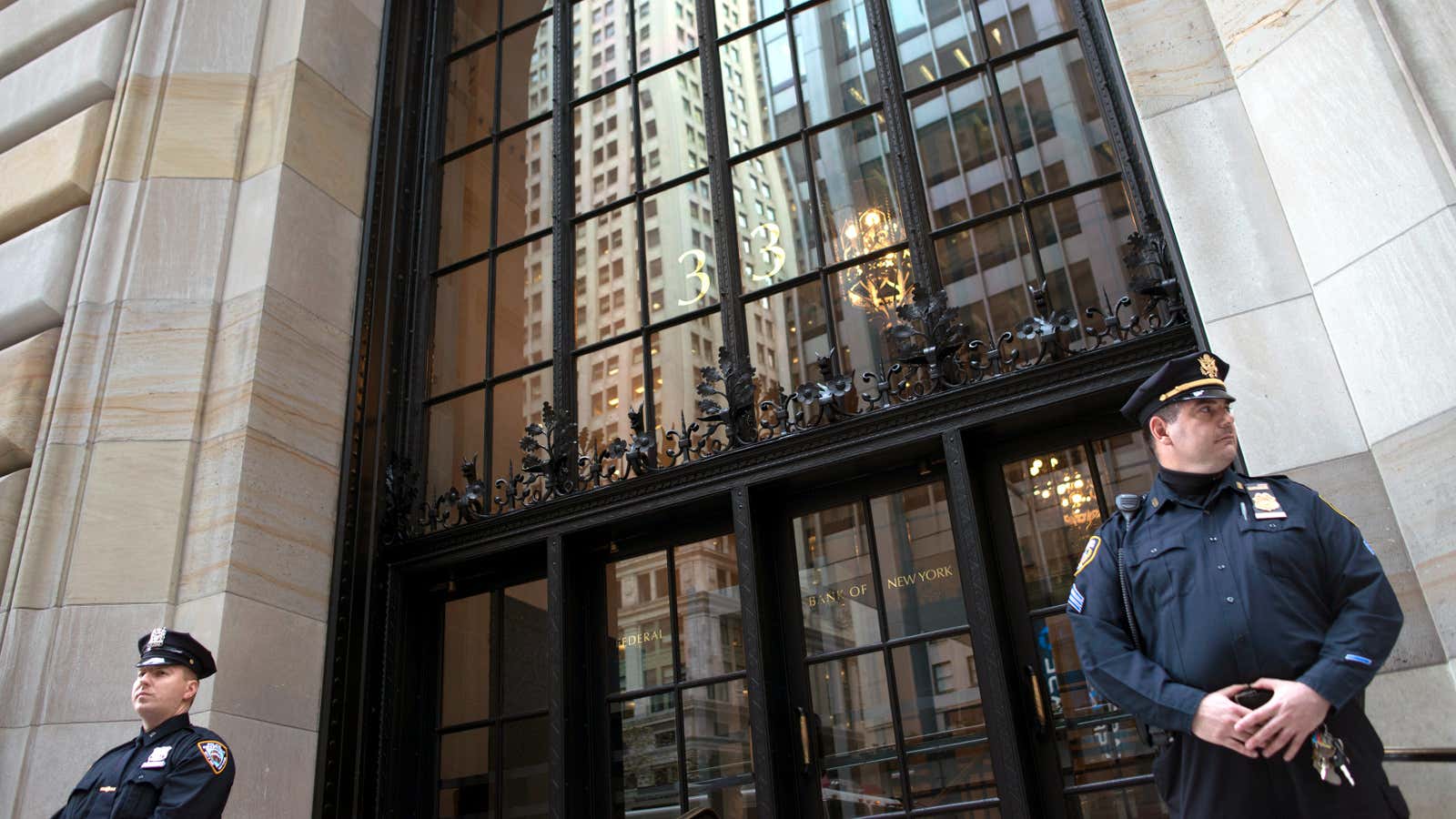The taped meetings between Federal Reserve examiners and Goldman Sachs executives show the stultifying office politics that could bring ruin to a financial system.
It’s worth your time to read the entire story by ProPublica or listen to the tapes themselves on This American Life, but the gist is this: A gung-ho attorney named Carmen Segarra was sent by the Fed to join a team supervising Goldman Sachs and was immediately struck by what she saw as her colleagues’ inappropriate deference to the firm. She began secretly recording meetings, was eventually fired by the Fed after seven months of employment, and sued the institution for $7 million; the case was dismissed but she is appealing. And now she’s shared 46 hours of tapes, which revolve around two key incidents:
- A deal Goldman made with Banco Santander, which appeared to regulators to require Fed approval that was never given. (Goldman agreed to hold securities owned by Santander’s Brazilian subsidiary, helping the Spanish bank skirt certain capital requirements.) Mike Silva, the Fed’s top supervisor over Goldman, and Segarra’s boss, tells his team in the tapes that he will push back against the firm for closing the deal without proper approval, but wilts and fails to press the executives, who insist there was no need for the approval in the first place. The bank, when contacted by Quartz, declined to comment on the transaction and the story, pointing us toward its statement to ProPublica.
- During an investigation of a different Goldman deal that included conflicts of interests that a judge called “troubling” and “furtive,” Segarra, an expert in regulatory compliance, argued that the bank’s conflict of interest policy was so vague as to be nonexistent. Bank officials and, eventually, the Fed, concluded the policy was at worst in need of improvement. Tapes of Silva pressing Segarra to change her conclusions depict a man pressured from above to make compromises with the bank he is ostensibly monitoring on behalf of the public. William Dudley, the president of the New York Federal Reserve bank then and now, spent two decades working at Goldman.
What most baffled Segarra was the fear her colleagues had of upsetting Goldman when they were empowered by law to demand information and punish infractions; Goldman had no apparent leverage over the Federal Reserve, which is quite literally the most powerful institution in the world. But social pressure from above and the specter of the revolving door—even Segarra applied to Goldman Sachs three times while a financial sector lawyer—made her colleagues unwilling to challenge the bank.
This dovetails with a report commissioned by the Fed after the financial crisis that found the institution’s culture woefully unprepared for the kind of aggressive supervision called for by the experience of the financial crisis—too close to financial institutions and intolerant of dissent. It recommended that the Fed ”demand from [examiners] a more distanced, high-level and skeptical view of how their bank tries to make money and what distinctive risks this entails.”
The question, then, is this: Has the Fed learned nothing from its own study of the crisis? Its official statement about the story denies Segarra’s allegations and points to structural reforms made to increase expertise and transparency at financial institutions it supervises, but doesn’t refer to the culture its own organization.
A senior New York Federal Reserve official who spoke to Quartz about the Segarra tapes emphasized that the Fed’s reforms are designed to bring senior Fed officials into the supervision process, because their experience leaves them better equipped to challenge bank officials. But Silva, the senior official monitoring Goldman, appeared less confident challenging bank executives than Segarra, a relatively new hire.
“That was a small slice, a tiny observation out of many interactions that Mike would have had with the organization,” the official said of the taped meetings. “My feeling is that the efforts to bring their expertise, their knowledge and strength of voice to the conversations has really enhanced our ability to supervise the firms. We have folks that were in firms themselves, that understand the business at a deep level, and can challenge.”
The official also felt that there was “zero credence” to the idea that reprimands of Segarra for arrogance and sharp elbows had anything to do with her being a woman or a minority. “We have a culture that encourages people to raise questions, to raise their hand, when you’re in a room, it’s the best ideas that wins, it’s not the person who’s the most senior in the room that wins,” the official said.
The official also lamented that there was little avenue to respond in detail to the tapes, between the on-going litigation and strict rules about what Fed officials can say about their knowledge of a bank’s activities, telling Quartz that “we are unable to defend ourselves in this case, and if I speak about it, I go to jail, because it is against the law.”
The conflicting accounts in this case may not be resolved for years, but the lesson is clear: The new powers of government officials charged with supervising private companies matter only if the officials are willing to exercise them. And as hard as it was for lawmakers to overhaul the regulatory framework, overhauling a culture is a much harder process.
